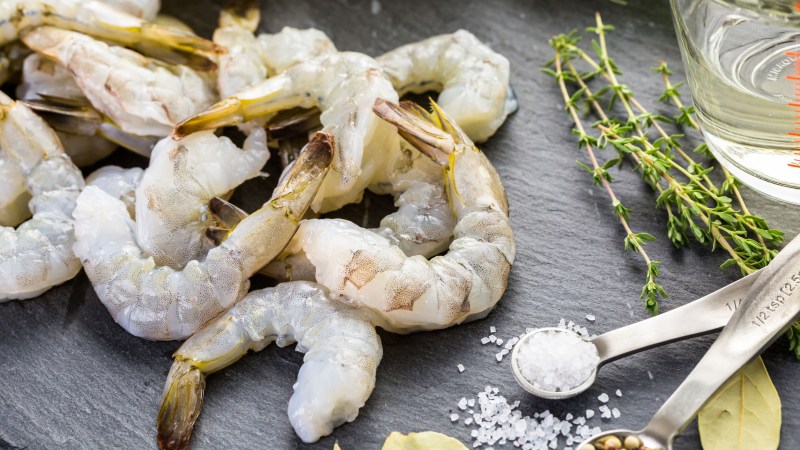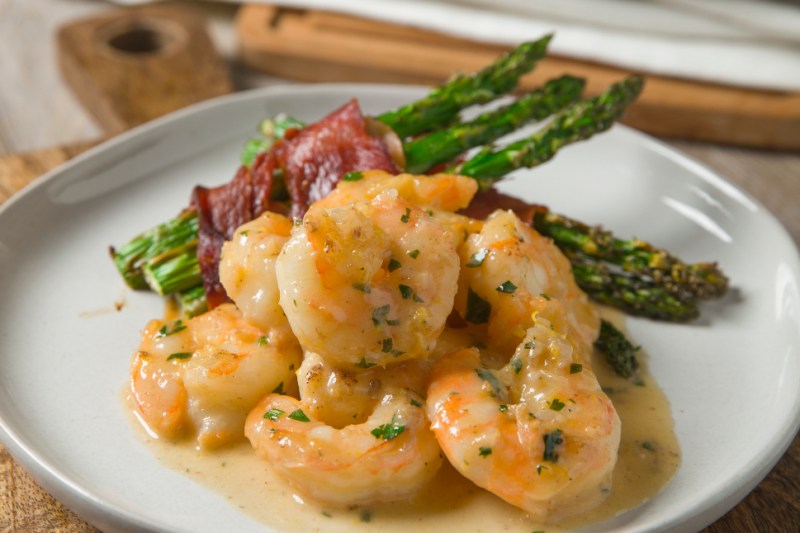
Garlicky and buttery, shrimp scampi is equally delicious by itself or with pasta. An Italian American creation, versions of shrimp scampi can be found in many seafood restaurants. But shrimp scampi is actually quite easy to make at home — the key is good quality shrimp and fresh ingredients. Keep reading our guide and find out how to make shrimp scampi right at home in your own kitchen.
What is scampi?

The word scampi actually refers to langoustines, a small, lobster-like shellfish popular in the Mediterranean and Europe. When Italian immigrants came to America, they adapted the recipe to use shrimp, a more available shellfish than langoustines in America. The seasoning remained similar regardless of shellfish choice — a combination of olive oil, garlic, onion, and white wine.
A little history on shrimp scampi
Some theories suggest shrimp scampi emerged from Italian immigrants in America adapting their recipes. Unable to find langoustines easily, they substituted shrimp, a more accessible ingredient. This take on scampi might have been created by fishermen using their fresh catches. There’s no pinpoint origin date, but estimates place the rise of shrimp scampi around the 1920s. It gained significant popularity in the U.S. and beyond after World War II. So, while the dish itself is likely an Italian-American creation, it draws inspiration from a classic Italian seafood preparation.
Selecting the shrimp

For scampi, any shrimp size is suitable ranging from jumbo to medium-sized shrimp. Just be sure to properly clean and prep your shrimp if purchased whole — shrimp scampi is best with shellless shrimp as this allows the flavors to soak into the shrimp meat. A key point to remember is that shrimp overcooks quickly, so timing is important. It can be helpful to take out your shrimp just before it’s completely cooked (this takes some experience to gauge the timing). The shrimp will continue to cook as it sits and when incorporated into the scampi sauce.
To serve, enjoy your shrimp scampi over pasta, with a side of vegetables or alongside steak as surf and turf. Also, feel free to add ingredients like tomatoes, seasoned breadcrumbs or herbs like tarragon for a different flair.
Pro tip: Have some good-quality, crusty bread on the side to soak up all the leftover sauce.
Shrimp scampi with prosciutto-wrapped asparagus

(By Ray Rastelli, Jr. Founder, Rastelli Foods Group)
Rastelli Foods is a New Jersey-based grocery delivery service that offers responsibly sourced meat and seafood. All seafood at Rastelli is wild-caught or raised in the wild, using certified sustainable practices. Customers can build their own handcrafted boxes for one-time or recurring deliveries.
Ingredients:
For the shrimp:
- 1 pound shrimp
- 3 tablespoons extra virgin olive oil
- 2 tablespoons garlic, roasted and mashed
- 2 tablespoons shallot, finely diced
- 1/2 cup white wine
- 1 lemon
- 1/4 pound butter, cubed
- 2 tablespoons Italian parsley, chopped
- Salt and pepper to taste
For the prosciutto-wrapped asparagus:
- 1/2 bunch asparagus
- 2 tablespoons extra virgin olive oil
- 4 slices prosciutto
- 4 tablespoons parmesan cheese, grated
- Salt and cracked black pepper to taste
Method:
- Preheat oven to 375 degrees Fahrenheit. Separate the asparagus into four equal portions and dress with the olive oil, grated parmesan, and salt and pepper. Wrap each bunch of asparagus with a slice of the prosciutto and bake for 8-10 minutes, until the asparagus is softened and the prosciutto is crispy.
- In a medium saute pan, heat the olive oil over medium heat and add the raw shrimp. Saute for 2 minutes on each side. Add the shallots and roasted garlic. Continue to cook all ingredients until the shrimp become red in color and the center is no longer opaque.
- Deglaze the pan with the white wine and allow to cook for 1 minute. Add the butter to the pan by swirling it into the remaining liquid, creating a pan sauce. Finish the sauce with the juice and zest of the lemon, Italian parsley, salt, and pepper.
- Top the cooked shrimp and sauce over top of the asparagus and serve. Tip: Roasted garlic will give your scampi sauce a smoother flavor, but raw garlic can be used if you don’t have time to roast the garlic. The shrimp can also be used as a sauce for pasta by adding stock and more butter.



